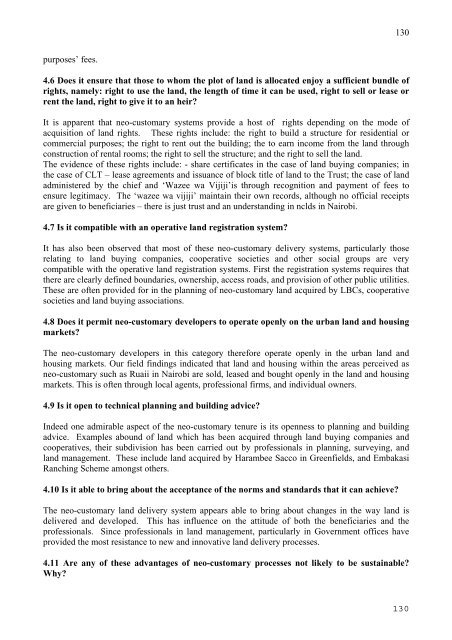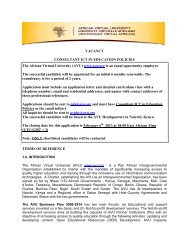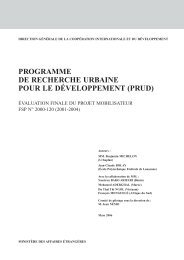Create successful ePaper yourself
Turn your PDF publications into a flip-book with our unique Google optimized e-Paper software.
130purposes’ fees.4.6 Does it ensure that those to whom the plot of land is allocated enjoy a sufficient bund<strong>le</strong> ofrights, namely: right to use the land, the <strong>le</strong>ngth of time it can be used, right to sell or <strong>le</strong>ase orrent the land, right to give it to an heir?It is apparent that neo-customary systems provide a host of rights depending on the mode ofacquisition of land rights. These rights include: the right to build a structure for residential orcommercial purposes; the right to rent out the building; the to earn income from the land throughconstruction of rental rooms; the right to sell the structure; and the right to sell the land.The evidence of these rights include: - share certificates in the case of land buying companies; inthe case of CLT – <strong>le</strong>ase agreements and issuance of block tit<strong>le</strong> of land to the Trust; the case of landadministered by the chief and ‘Wazee wa Vijiji’is through recognition and payment of fees toensure <strong>le</strong>gitimacy. The ‘wazee wa vijiji’ maintain their own records, although no official receiptsare given to beneficiaries – there is just trust and an understanding in nclds in Nairobi.4.7 Is it compatib<strong>le</strong> with an operative land registration system?It has also been observed that most of these neo-customary delivery systems, particularly thoserelating to land buying companies, cooperative societies and other social groups are verycompatib<strong>le</strong> with the operative land registration systems. First the registration systems requires thatthere are c<strong>le</strong>arly defined boundaries, ownership, access roads, and provision of other public utilities.These are often provided for in the planning of neo-customary land acquired by LBCs, cooperativesocieties and land buying associations.4.8 Does it permit neo-customary developers to operate openly on the urban land and housingmarkets?The neo-customary developers in this category therefore operate openly in the urban land andhousing markets. Our field findings indicated that land and housing within the areas perceived asneo-customary such as Ruaii in Nairobi are sold, <strong>le</strong>ased and bought openly in the land and housingmarkets. This is often through local agents, professional firms, and individual owners.4.9 Is it open to technical planning and building advice?Indeed one admirab<strong>le</strong> aspect of the neo-customary tenure is its openness to planning and buildingadvice. Examp<strong>le</strong>s abound of land which has been acquired through land buying companies andcooperatives, their subdivision has been carried out by professionals in planning, surveying, andland management. These include land acquired by Harambee Sacco in Greenfields, and EmbakasiRanching Scheme amongst others.4.10 Is it ab<strong>le</strong> to bring about the acceptance of the norms and standards that it can achieve?The neo-customary land delivery system appears ab<strong>le</strong> to bring about changes in the way land isdelivered and developed. This has influence on the attitude of both the beneficiaries and theprofessionals. Since professionals in land management, particularly in Government offices haveprovided the most resistance to new and innovative land delivery processes.4.11 Are any of these advantages of neo-customary processes not likely to be sustainab<strong>le</strong>?Why?130
















